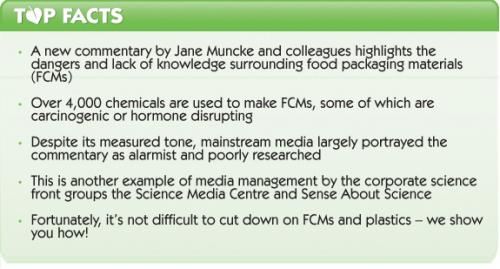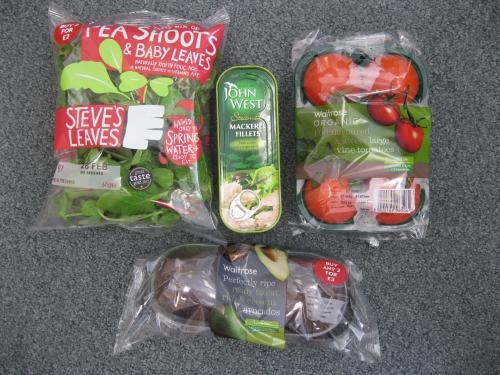Adam Smith
Science & communications officer, ANH-Intl
A new report serves as a timely reminder that the modern practice of covering our food in endless acres of plastic may not be the best idea for our health. And yet, despite its measured tone, the report was painted as alarmist by an industry-friendly media. But should you be concerned and make efforts to reduce your exposure to food packaging of all kinds? Read on and make your own mind up.

It’s hard eating healthily
I’ve just finished my lunch (delicious, I might add). And I did my best: I bought it from the UK’s most principled supermarket, the organic-friendly Waitrose; the salad items were organic wherever possible – which is less than usual, as our local Waitrose in Dorking, Surrey is being rebuilt and the temporary store is tiny – and the resulting salad contained decent amounts of healthy fats, proteins and phytonutrients. Go me!
However, there was one tiny snag. Take a look at the photo below and see if you can spot it.

Adam's healthy lunch covered in not-very-healthy plastic
If you spotted that all that goodness was swathed in plastic, you clearly think along similar lines to Jane Muncke and colleagues, authors of a new commentary published in the Journal of Epidemiology and Community Health.
A recurring problem
Contamination is everywhere at the moment – in more ways than one. Last week, we investigated the ‘nasties’ that may be lurking in your favourite food supplements and herbal products, and this week Muncke et al are on hand to remind us that food contact materials (FCMs) are “as ubiquitous as particulate air pollution...[they] have long posed a silent challenge to researchers concerned with human health, nutrition and the environment.” In their 2-page commentary, the authors make some sobering points:
- Chemicals contained in FCMs can migrate into the foods they enclose
- Not all migrating chemicals are regulated. The US regulatory category is ‘indirect food additives’, while the European Union (EU) has the usual thicket of Directives and Regulations relating to FCMs in place. Perhaps most relevant are the framework Regulation 1935/2004 and Regulation 10/2011 (as amended), which defines those substances that can legally be part of the plastics manufacturing process. The latter Regulation also sets migration limits for plastic-based FCMs and individual substances
- Humans eating packaged or processed foods – i.e. the vast majority of the industrialised world – ingest small amounts of chemical contaminants from FCMs throughout their lives
- FCM ingredients, of which over 4,000 are known, include confirmed carcinogens and controversial endocrine-disrupting chemicals (EDCs)
- EDCs may demonstrate “non-monotonic dose–response curves” such as hormesis. In simple language, endocrine disruptors don't always show a typical dose response in which the effect gets progressively more serious as the dose increases. Sometimes the dose–response is very unpredictable and the adverse effects may become even more serious as the dose declines, in some cases even when the starting dose is very low. This has caused many experts who study endocrine disruptors to propose that there is no safe dose. As such, the current practice of testing substances at high doses and then estimating their effects at low doses may be woefully misguided
- The effects of mixtures of FCM ingredients is largely unstudied
- Because almost everyone is exposed to FCMs, no unexposed, reference control group exists – making it doubly difficult to establish causal links between FCM exposure and chronic disease. The authors conclude with some suggestions for future work in this regard.
Nothing to see here
Now here’s an interesting thing. This was not a particularly remarkable article – no high-profile authors, no original research presented, merely a brief commentary on an area that clearly needs further study – and the UK’s Guardian newspaper initially reported it as such. Strangely, a second article by the same journalist was published at 19.23 on the same day that the original article was posted, at 00.01 (click on the ‘Article history’ link for details). By this time, we were told that the Muncke et al commentary had been “roundly rejected”.
The intervening 7 hours was apparently enough for the Science Media Centre (SMC) to do its job. Three of the five scientists providing opinions for its ‘Expert reaction to food packaging chemicals and health’ were directly quoted in the new and ‘improved’ Guardian piece, all pouring entirely unreferenced scorn on the idea that FCMs could pose any kind of threat to human health. Prof David Coggon even declared that understanding of multiple chemical exposure “has advanced a lot in the past 15 years, and there is little to suggest that such combined exposures pose a threat to health” – a shockingly blasé attitude that appears unique to Prof Coggon. Once again, it appears that the SMC and Sense About Science (SAS) – the Tweedledum and Tweedledee of establishment, pro-industry science – have taken advantage of the appalling standard of modern journalism to counter a potentially threatening publication.
Cutting back on the plastic is easy
The organic movement is growing alongside the natural healthcare movement, and it’s no coincidence that they advocate avoiding man-made chemicals like pesticides or plastics, and detoxifying from them when necessary. It’s also no coincidence that pro-industry lapdogs like SAS and SMC expend huge amounts of energy attempting to discredit both movements, and related research like that by Muncke et al. The disgrace is that it is now screamingly obvious that something has to change, for the sake of ourselves, our children and our planet.
Fortunately, it’s easy to cut back on potentially toxic food packaging and plastics:
- Go organic! Sounds simple and easy, and it largely is. Get involved with an organic food box scheme, a local farmers’ market or even grow your own. As we’ve seen, even supermarket organic produce can come wrapped in plenty of unnecessary plastic
- Use glass instead of plastic drinking and storage utensils, especially if you’re storing something acidic like lemon juice or kombucha
- Always buy products in glass bottles instead of plastic ones if you can, especially with acidic products like vinegar
- Minimise the use of plastic fridge and freezer bags and always avoid putting hot foods into plastic cartons, bags or storage vessels
- Never cook using Teflon non-stick kitchenware and avoid aluminium. Use stainless steel or non-stick ceramic cookware
- If you drink takeaway hot beverages, don’t drink them through the plastic lid – always remove it before drinking
- Despite all of our best efforts, unhealthy food packaging is unlikely to disappear overnight, so please always dispose responsibly and recycle where you can.








Comments
your voice counts
27 February 2014 at 10:25 pm
Thank you for your useful analysis of this issue. I would just like to add that some products, such as Colgate toothpaste for 0-3 year olds actually have plastic in them and are directly ingested. It contains Polyethelene.
Your voice counts
We welcome your comments and are very interested in your point of view, but we ask that you keep them relevant to the article, that they be civil and without commercial links. All comments are moderated prior to being published. We reserve the right to edit or not publish comments that we consider abusive or offensive.
There is extra content here from a third party provider. You will be unable to see this content unless you agree to allow Content Cookies. Cookie Preferences